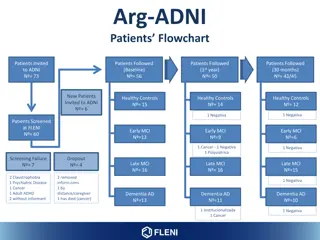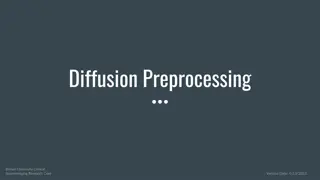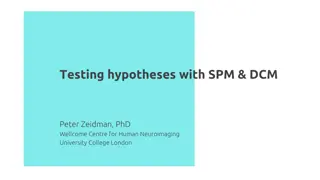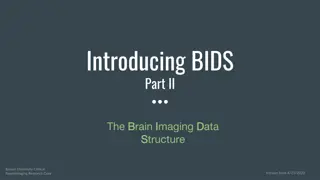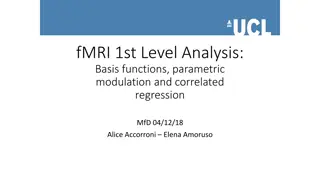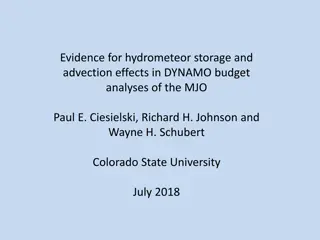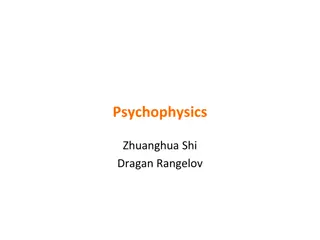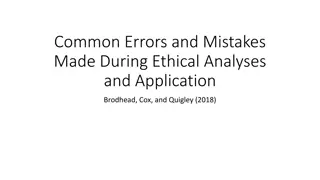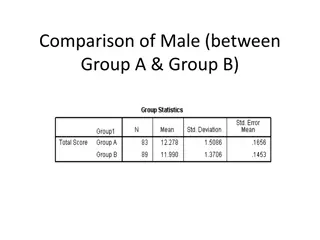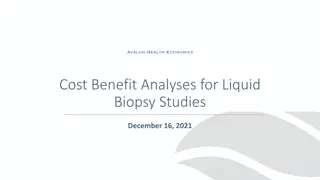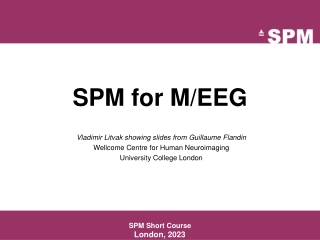Neuroimaging Group Analyses: Methods and Results Overview
In this collection of images and descriptions, various aspects of group analyses in neuroimaging research are explored, including statistical parametric mapping, first-level analyses, and assessing different subjects using fixed effects, random effects, and mixed effects analysis. The content delves into subject variability, model designs, and interpreting results through multiple statistical approaches.
Download Presentation

Please find below an Image/Link to download the presentation.
The content on the website is provided AS IS for your information and personal use only. It may not be sold, licensed, or shared on other websites without obtaining consent from the author. Download presentation by click this link. If you encounter any issues during the download, it is possible that the publisher has removed the file from their server.
E N D
Presentation Transcript
Group Analyses Tobias Hauser Max Planck UCL Centre for Computational Psychiatry and Ageing Research Wellcome Centre for Human Neuroimaging University College London With many thanks to G. Flandin, W. Penny, S. Kiebel, T. Nichols, R. Henson, J.-B. Poline, F. Kherif SPM Course London, October 2018
Image time-series Statistical Parametric Map Design matrix Spatial filter Realignment General Linear Model Smoothing Statistical Inference RFT Normalisation p <0.05 Anatomical reference Parameter estimates
Donald Trump area Effect size, c ~ 4 Within subject variability, sw~0.9
Subject N Effect size, c ~ 2 Within subject variability, sw~1.5
GLM: repeat over subjects SPM{t} fMRI data Design Matrix Contrast Images Subject 1 Subject 2 Subject N
First level analyses (p<0.05 FWE): Data from R. Henson
How to assess these different subjects? Fixed Effects Analysis (FFX) Random Effects Analysis (RFX) Summary Statistics approach Mixed Effects Analysis (MFX)
Fixed effects analysis (FFX) Modelling all subjects at once Subject 1 Subject 2 Subject 3 Subject N
Fixed EffectsAnalysis (FFX) Time series are effectively concatenated as though we had one subject with N=50x12=600 scans. sw= [0.9, 1.2, 1.5, 0.5, 0.4, 0.7, 0.8, 2.1, 1.8, 0.8, 0.7, 1.1] Mean effect, m=2.67 Average within subject variability (stand dev), sw=1.04 Standard Error Mean (SEMW) = sw/sqrt(N)=0.04 Is effect significant at voxel v? t=m/SEMW=62.7 p=10-51
Fixed effects analysis (FFX) ( ) 1 ( ) 1 ( ) 1 Modelling all subjects at once = X + y Simple model Lots of degrees of freedom ) 1 ( 1 X ( ) 1 y = + ( ) 1 Large amount of data Assumes common variance over subjects at each voxel ) 1 ( 2 X ) 1 ( 3 X
Fixed effects ( ) 1 ( ) 1 ( ) 1 = X + y Only one source of random variation (over sessions): measurement error Within-subject Variance True response magnitude is fixed. How consistent is the response within this group of people, no inference about the population
Random effects ( ) 1 ( ) 1 ( ) 1 = + + y X ( ) 1 ( ) 2 ( ) 2 ( ) 2 = X Two sources of random variation: measurement errors response magnitude (over subjects) Response magnitude is random each subject/session has random magnitude Within-subject Variance Between-subject Variance
Random effects ( ) 1 ( ) 1 ( ) 1 = + + y X ( ) 1 ( ) 2 ( ) 2 ( ) 2 = X Two sources of random variation: measurement errors response magnitude (over subjects) Response magnitude is random each subject/session has random magnitude but population mean magnitude is fixed. Within-subject Variance Between-subject Variance
Random EffectsAnalysis (RFX) For group of N=12 subjects effect sizes are c = [4, 3, 2, 1, 1, 2, 3, 3, 3, 2, 4, 4] Group effect (mean), m=2.67 Between subject variability (stand dev), sb=1.07 Standard Error Mean (SEM) = sb/sqrt(N)=0.31 Is effect significant at voxel v? t=m/SEM=8.61 p=10-6
Random EffectsAnalysis (RFX) For group of N=12 subjects effect sizes are c= [3, 4, 2, 1, 1, 2, 3, 3, 3, 2, 4, 4] Group effect (mean), m=2.67 Between subject variability (stand dev), sb=1.07 This is called a Random Effects Analysis because we are comparing the group effect to the between- subject variability.
Random effects 2 ?? 2 ?? Probability model underlying random effects analysis
Fixed vs random effects With Fixed Effects Analysis (FFX) we compare the group effect to the within-subject variability. It is not an inference about the population from which the subjects were drawn. With Random Effects Analysis (RFX) we compare the group effect to the between-subject variability. It is an inference about the population from which the subjects were drawn. If you had a new subject from that population, you could be confident they would also show the effect.
Fixed vs random effects Fixed isn t wrong , just usually isn t of interest. Summary: Fixed effects inference: I can see this effect in this cohort Random effects inference: If I were to sample a new cohort from the same population I would get the same result
How to assess these different subjects? Fixed Effects Analysis (FFX) Random Effects Analysis (RFX) Summary Statistics approach Mixed Effects Analysis (MFX)
Summary Statistics Approach First level Data Design MatrixContrast Images
Summary Statistics Approach c T c First level Second level t = ) T ( r a V Data Design MatrixContrast Images SPM(t) One-sample t-test @ 2nd level
plotting data Go to a voxel and press PLOT -> Plot against scan or time
Summary Statistics RFX Approach Assumptions The summary statistics approach is exact if for each session/subject: Within-subjects variances the same First level design the same (e.g. number of trials) Other cases: summary statistics approach is robust against typical violations. Mixed-effects and fMRI studies. Friston et al., NeuroImage, 2005. Statistical Parametric Mapping: The Analysis of Functional Brain Images. Elsevier, 2007. Simple group fMRI modeling and inference. Mumford & Nichols. NeuroImage, 2009.
Summary Statistics RFX Approach Robustness Summary statistics Hierarchical Model Viewing faces Listening to words Mixed-effects and fMRI studies. Friston et al., NeuroImage, 2005.
Terminology Hierarchical linear models: Random effects models Mixed effects models Nested models Variance components models all the same all alluding to multiple sources of variation (in contrast to fixed effects)
Hierarchical models ( ) 1 ( ) 1 ( ) 1 = + + y X Example: Two level model ( ) 1 ( ) 2 ( ) 2 ( ) 2 = X ) 1 ( 1 X y ( ) 1 = + ( ) 1 ( ) 1 ( ) 2 ( ) 2 + = ) 1 ( 2 ( ) 2 X X ) 1 ( 3 X Second level First level
Hierarchical models Restricted Maximum Likelihood (ReML) Parametric Empirical Bayes Expectation-Maximisation Algorithm But: Many two level models are just too big to compute. And even if, it takes a long time! Any approximation? spm_mfx.m Mixed-effects and fMRI studies. Friston et al., NeuroImage, 2005.
Do MFX models when ...Summary statistics assumptions are violated Largely different subject-level designs Within-subject variances are different (in practice: you don t trust your results benefit from more precise variance estimates you have a lot of computing power and time)
How to assess these different subjects? Fixed Effects Analysis (FFX) Random Effects Analysis (RFX) Summary Statistics approach Mixed Effects Analysis (MFX) Beyond one-sample t-tests Paired t-tests ANOVAs
ANOVA & non-sphericity One effect per subject: Summary statistics approach One-sample t-test at the second level More than one effect per subject or multiple groups: Non-sphericity modelling Covariance components and ReML
ANOVA Condition 1 Condition 2 Condition3 Sub1 Sub2 ... Sub12 Sub13 Sub14 ... Sub24 Sub25 Sub26 ... Sub36 ANOVA at second level (eg clinical populations). If you have two conditions this is a two-sample t-test.
ANOVA within subject Condition 1 Condition 2 Condition3 Sub1 Sub2 ... Sub12 Sub1 Sub2 ... Sub12 Sub1 Sub2 ... Sub12 ANOVA within subjects at second level (eg same subjects on placebo, drug1, drug2). This is an ANOVA but with subject effects removed. If you have two conditions this is a paired t-test.
SPM interface: factorial design specification Many options One-sample t-test Two-sample t-test Paired t-test Multiple regression One-way ANOVA One-way ANOVA within subject Full factorial Flexible factorial
GLM assumes Gaussian spherical (i.i.d.) errors Examples for non Examples for non- -sphericity sphericity: : sphericity = iid: error covariance is scalar multiple of identity matrix: Cov(e) = 2I 4 0 = (e ) Cov 0 1 non-identically distributed 2 1 = (e ) Cov 1 2 1 0 = (e ) Cov non-independent 0 1
2nd level: Non-sphericity Error covariance matrix Errors are independent but not identical (e.g. different groups (patients, controls)) Errors are not independent and not identical (e.g. repeated measures for each subject (multiple basis functions, multiple conditions, etc.))
Summary Group Inference usually proceeds with RFX analysis, not FFX. Group effects are compared to between rather than within subject variability. Hierarchical models provide a gold-standard for RFX analysis but are computationally intensive. Summary statistics approach is a robust method for RFX group analysis. Can also use ANOVA or ANOVA within subject at second level for inference about multiple experimental conditions or multiple groups.
Bibliography: Statistical Parametric Mapping: The Analysis of Functional Brain Images. Elsevier, 2007. Generalisability, Random Effects & Population Inference. Holmes & Friston, NeuroImage,1998. Classical and Bayesian inference in neuroimaging: theory. Friston et al., NeuroImage, 2002. Classical and Bayesian inference in neuroimaging: variance component estimation in fMRI. Friston et al., NeuroImage, 2002. Mixed-effects and fMRI studies. Friston et al., NeuroImage, 2005. Simple group fMRI modeling and inference. Mumford & Nichols, NeuroImage, 2009.


